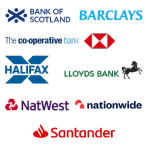Our Top 3 Digital Money Transfer Providers for UK to USA
| Provider | Amount To Send | Fee | Exchange Rate | Speed | ||
|---|---|---|---|---|---|---|
 |
TorFX | GBP £10,000.00 | No Fee | 1.3367 | 1-3 days | more... |
 |
Currencies Direct | GBP £10,000.00 | No Fee | 1.3367 | 1-3 days | more... |
 |
OFX (UK) | GBP £10,000.00 | No Fee | 1.3314 | 1-3 days | more... |







